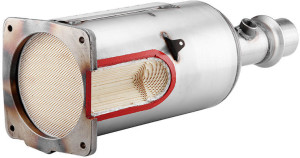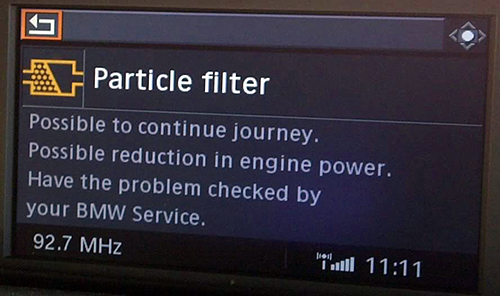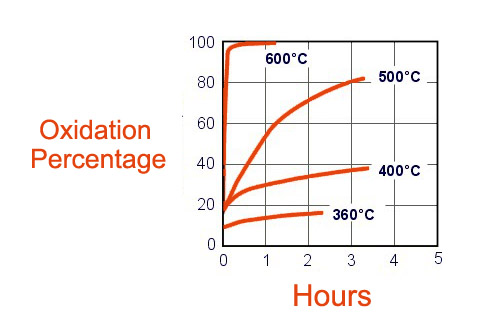In this overview of Diesel Particulate Filters (DPF’s), which is aimed at experienced petrol technicians that have not had much, or any, exposure to diesel technology, we will briefly discuss the following; what diesel particulate filters are, why we need them, how they work, and why they fail, starting with...

In simple terms, a DPF is a device that is designed specifically to capture solid particulate matter (soot) in diesel exhaust. Depending on the filtration medium used, efficiencies of close to 100% in trapping solid particulate matter are possible; therefore, modern DPF technologies have now become the most effective means of controlling, if not always eliminating particulate emissions on diesel-powered applications. Note however, that despite its high efficiency, DPF technology does not, and cannot control the gaseous fractions of diesel emissions.
In practice, the combustion of diesel fuel is seldom complete, which has the result that relatively large volumes of hydrocarbons in the form of soot are generated even in the most efficient diesel engines. However, while emission control measures on diesel applications have reached a high level of refinement, and hence, efficiency, the introduction of Euro 5/6 emissions regulations in most jurisdictions had forced car makers to address the problem of solid particle emissions, which existing methods such as SCR (Selective Catalytic Reduction) technologies could not control or eliminate.
Although the introduction of low-sulphur diesel fuel (which produces fewer emissions than diesel with high sulphur content), had the effect of measurably reducing the formation of soot in diesel engines, most diesel engines still produced volumes of soot that exceeded maximum allowable levels in most jurisdictions. Because of this, many jurisdictions introduced policies in the mid-1990’s that forced transport operators to retrofit their fleets with DPF devices, while at the same time, obligating car manufacturers to fit DPF devices as standard equipment on new vehicles.
As the name suggests, DPF’s are filters that are designed to filter out solid particulate matter from diesel exhaust, while allowing the gaseous fraction of the exhaust stream to pass through the device relatively unimpeded. However, DPF devices are not created equal, and both their efficiency and durability largely depend on the filter medium used. Nonetheless, all DPF devices have to conform to minimum standards, these standards being:
The device must be capable of trapping fine soot particles that are typically one micron, and smaller, in diameter
The device must not create excessive exhaust gas back pressure
The device must be cost effective
It must be possible to mass-produce the device to close tolerances
The device must be durable
In practice though, and despite the above, many of the issues that beset DPF devices can be traced back to the type of filter medium used in the device. Knowing what material is present in the DPF can sometimes make diagnosing why the device failed easier, so below is a quick rundown on the most commonly found types of DPF devices that are in use today.
The most commonly used filter medium by far is cordierite, a ceramic material that is also commonly used for the substrate in catalytic converters. The main advantages of cordierite are that is relatively inexpensive, that it has high to excellent filtration efficiency and that its thermal properties make it easy to pack into the device.
However, since cordierite has a low melting point of about 200C , cordierite DPF filter cores have been known to melt during the regeneration process, and particularly in cases where the filter had become excessively loaded with soot. In practice however, this most commonly occurs on applications that employ a passive regeneration* process.
Cordierite DPF cores are easy to identify, since they look catalytic converter cores, but with alternate channels plugged to force the exhaust stream to flow through the wall, which allows soot particles to collect at a particular point in the core.
* See the section on Regeneration for more details.
In terms of both popularity and efficiency, silicon carbide (SiC) as a filter medium follows close behind cordierite, since it has a slightly higher melting point of about 700C. However, Sic is not as thermally stable as cordierite, which can complicate the process of manufacturing larger filter cores. While small cores can often be made in one piece, larger cores have to be made in several sections and “stuck” together with a bonding agent that allows for the thermal expansion of the core, thereby maintaining the cores’ structural integrity.
In terms of efficiency, SiC-based DPF devices are capable of wide-band filtration, and they can typically filter out soot particles in the 0.2-150 ?m range. In practice, this means that these types of cores are about 95% effective in removing all soot particles. Note that although Sic DPF cores are significantly more expensive than cordierite cores, the two types of cores are manufactured in similar sizes, which makes them interchangeable to a large degree.
Like cordierite cores, SiC-based cores also have alternate channels plugged, thus forcing the exhaust stream to flow through the wall, which allows soot particles to collect at a particular point in the core.
In these designs, several types of ceramic fibres are mixed together into a matrix that can be formed into almost any shape. The main advantage of this approach is that by varying the types of fibres used, the porosity of the resulting matrix can be varied to suit almost any application. For instance, the porosity of the matrix can be controlled to produce a high flow, low efficiency core, or a low flow, high efficiency core. Moreover, ceramic fibre cores have the added advantage over wall flow designs that efficiencies of greater than 95% can be achieved in removing the total mass of the accumulated soot deposits, and greater than 99% efficiency in removing the total number of accumulated soot particles. Both efficiencies can moreover be achieved over a wider range of engine operating conditions than is possible to do with wall flow designs, and at lower pressure drops across the device than is possible with other designs.
Nonetheless, due to their high efficiency, ceramic fibre cores have to be regenerated more often than other types of cores, which according to some sources, increases the total CO2 fraction of the engine’s emissions. However, while the regeneration process produces mainly water and CO2, the volume of CO2 that is produced during regeneration typically amounts to less than 0.05% or so of the engines’ total CO2 emission.
In these designs, fine metal fibres or strands are woven into a monolithic structure that has the advantage that an electric current can be applied to it to increase its temperature for the purposes of regeneration. In practice, cores of this type can not only be regenerated at lower exhaust gas temperatures than is possible with other designs; regeneration can also be accomplished at higher exhaust gas flow rates.
However, metal fibre cores are significantly more expensive than other types of cores, and are not interchangeable with other types of cores because metal fibre cores require an electrical current to work.
'Partial filters' refer to a variety of devices (using a wide variety of filter media) that offer efficiencies of between 50% and about 85%. Typically, these devices produce exhaust backpressures that fall somewhere between that of a catalytic converter and a proper DPF device. While these devices are no longer in common use, they were once a popular choice for retrofitting.
Single use paper cores can still be found in some specialised applications such as diesel generators and equipment such as forklifts that have to be used indoor, or in confined spaces for short periods of time. Note that paper cores are disposable, and therefore do not require a regeneration strategy.
Regardless of the type of DPF used, all DPF devices collect the solid particulate matter in diesel exhaust, and have to be regenerated, or 'cleaned out' from time to time. How often this happens largely depends on the type of DPF device used, as well as on how the vehicle is used, For instance, if the vehicle is used primarily in the urban setting, continual stop-start driving produces more soot than a similar vehicle that is primarily used for high-speed driving on freeways.
Nonetheless, all DPF devices eventually reach a point where the accumulated soot starts to affect engine operation and fuel economy, simply because the soot is effectively plugging the exhaust system. Thus, to monitor the efficiency of the DPF device and the flow rate of the exhaust gas through the device, most applications use exhaust gas pressure sensors to continually monitor the backpressure in the exhaust in real time. Note that is some cases, the system may use exhaust gas temperature sensors to monitor the efficiency of the DPF device as well.
Typically, ECU’s are programmed to recognise when the DPF has reached a load of about 40% 45% of its maximum allowable load of soot, based on input data from sensors that include (but are not limited to) the exhaust backpressure sensor(s). This value is then compared to pre-programmed look-up tables, and should the ECU determine that a specified load limit has been reached, it will initiate the regeneration process, which can be passive, or active, with the actual method depending on the application.
Note that on most applications, a third method, known as, forced regeneration, can be initiated with a scan tool during a diagnostic or repair process.

In simple terms, 'regeneration' means that a DPF devices’ ability to trap, or filter out solid particulate matter from diesel exhaust is restored, which as stated elsewhere, can be accomplished without driver intervention in one of two ways, these being-
During passive regeneration, the temperature of the exhaust stream is the primary source of heat, and the process generally takes place during high speed driving, or at least, at speeds in excess of 40 km/hour. However, since operating conditions do not always raise the exhaust gas temperature to the required level, the ECU may adjust the fuel injection timing and injector pulse width in order to create the required heat for the time required to burn off the accumulated soot in the DPF.
Note though that on some applications, a dedicated injection event (typically, post combustion) may also be used to generate the required heat. In these cases, fuel economy can be severely affected, and the creation of NOx is sometimes greatly increased.
During active DPF regeneration, the ECU is programmed to use post combustion injection events in order to raise the exhaust gas temperature to the required level. However, on applications that use metal fibre DPF cores, the ECU may also activate resistive heater elements within the core to assist in raising the core to the required temperature, which has the practical advantage of decreasing the time it takes to regenerate the DPF core.
Note though that on some applications, most notably some Ford and Volvo applications, a catalyst (typically cerium oxide) may also be injected into the exhaust stream. The catalyst significantly decreases the temperature at which diesel soot burns off which in turn, decreases fuel consumption during the regeneration process because less time is required to complete the process.
While neither passive nor active regeneration require any inputs or actions from the driver, there are many reasons why a regeneration process can fail to initiate or complete. In these cases, the DPF core almost always becomes clogged to the point where engine performance is affected, or in severe cases, where the ECU initiates a failsafe, or limp mode.
In such cases, a technician can force a regeneration of the DPF core with a high-end scan tool by following a prescribed, manufacturer-specific procedure. Note that depending on the soot load contained in the DPF core, the procedure may or may not be successful.
Essentially, the regeneration of a DPF device is accomplished by means of applying a suitable temperature, typically, about 600C to the soot load to burn off, or oxidise the soot in order to convert the soot to mainly CO2. Note though that this process can occur through reactions either with oxygen, or with nitrogen dioxide, depending on the system design.
In the case of oxygen-based reactions, the reaction is possible simply because diesel exhaust contains appreciable amounts of oxygen at almost all operating conditions. However, note that this process requires relatively high temperatures to achieve meaningful conversion rates, and that this process is typically found in active DPF regeneration processes that do not use catalysts.
The advantage of using a nitrogen dioxide-based reaction is that meaningful conversion rates can be achieved at lower temperatures. However, the process requires an increase in the nitrogen dioxide/nitrous oxide ratio, which is typically achieved by the use of a catalyst. This process is the most commonly used approach in both passive and active regeneration processes.
Regardless of the method of DPF regeneration though, all processes require a minimum temperature of about 600C to be effective. The graph below illustrates the point

From the above graph, it is obvious that the lower the exhaust gas temperature is, the longer it takes to oxidise the soot. However, even in the most effective systems, the rate at which diesel soot is converted into mainly CO2 is limited by the kinetics of the soot particles.
Put in another way, this means that soot particles cannot be oxidised in catalytic converters because the soot does not remain in the converter long enough. Essentially, since the soot passes through the catalytic converter before they can be oxidized, the DPF core is required to capture the soot particles, and to hold onto them long enough for the conversion process to be completed. Note though that the time it takes to regenerate a DPF core depends on the soot load; generally, the higher the soot load, the faster the process, and vice versa.
While DPF filters and their control systems are relatively trouble-free, it should be noted that there are some issues that can affect their operation, and that some of these issues are common to all applications. These could include:
Excessive oil consumption that could clog the DPF core
Over-fuelling over extended periods; in severe cases, un-burnt fuel can ignite in the exhaust system, thus causing temperatures that are high enough to melt both catalytic converter and DPF cores
Since biodiesel contains more oxygen than mineral diesel, the use of high concentrations of biodiesel can create excessively high temperatures, which can damage or even melt DPF cores
Contaminated, dirty, or substandard fuel
Contaminated catalyst, or a low catalyst level on applications that use a catalytic-based regeneration process
Unauthorised, or illegal modifications to the exhaust system, and/or fuel and engine management systems
We recommend downloading this handy diagnosis chart by Ryco Filters
NOTE: The initiation of passive regeneration in a variety of applications during urban, low-speed driving conditions has been reported in a significant number of cases in several markets. It will be recalled that passive regeneration should only occur under high-speed driving conditions; however, in many cases the root cause(s) of why the process had been initiated in city driving conditions remains unknown.
Courtesy of Ryco Filters